
|
MIMI Experiment on Cassini
|
 |

|
MIMI Experiment on Cassini
|
 |
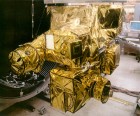 The Magnetosphere Imaging Instrument (MIMI) is a neutral and charged particle detection system on the CASSINI orbiter spacecraft designed to study the overall configuration and dynamics of Saturn's magnetosphere, and its interaction with the solar wind, Saturn's atmosphere, Titan, and the icy satellites.
The Magnetosphere Imaging Instrument (MIMI) is a neutral and charged particle detection system on the CASSINI orbiter spacecraft designed to study the overall configuration and dynamics of Saturn's magnetosphere, and its interaction with the solar wind, Saturn's atmosphere, Titan, and the icy satellites.
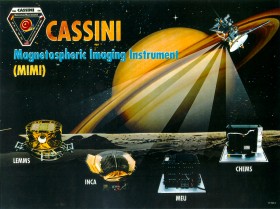 MIMI consists of three different sensors which were built at different institutions in Europe and the United States. The principal Investigator is S.M. Krimigis from the Applied Physics Laboratory of the Johns Hopkins University, Laurel, Maryland, USA.
MIMI consists of three different sensors which were built at different institutions in Europe and the United States. The principal Investigator is S.M. Krimigis from the Applied Physics Laboratory of the Johns Hopkins University, Laurel, Maryland, USA.
The different subsystems are:
|
|
Science objectives |
|
|
Investigators |
|
|
Instrument description |
|
|
People involved |
|
|
Calibration Campaigns |
|
|
Daily updated summary plots |
|
|
Periapsis data |
|
MIMI publications by MPS members |
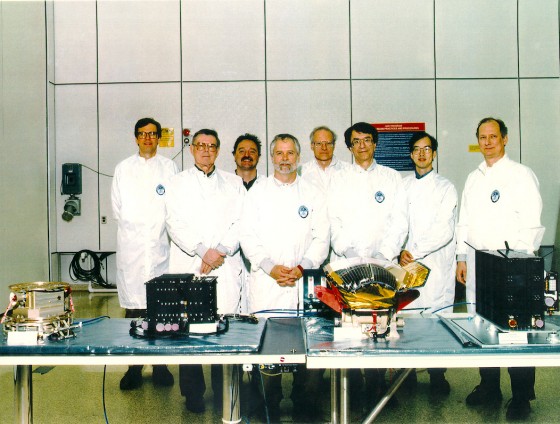
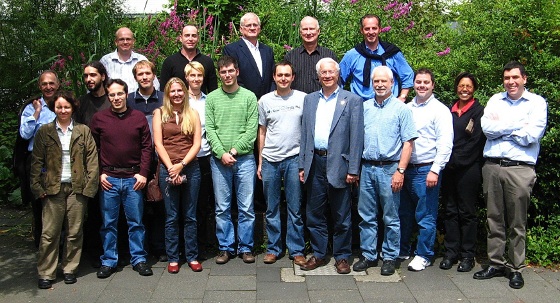
| Principal Investigator | S.M. Krimigis |
The Johns Hopkins University Applied Physics Laboratory Laurel, MD 20723 USA Office for Space Research and Applications Academy of Athens Athens Greece |
| Team members @ APL | A.F. Cheng
E.P. Keath (ret.) B.H. Mauk R.W McEntire (ret.) D.G. Mitchell E.C. Roelof D.J. Williams (ret.) M. Hill P. Brandt A. Rymer T.Smith |
The Johns Hopkins University Applied Physics Laboratory Laurel, MD 20723 USA |
| Team members @ Max Planck Institute for Solar System Research | N. Krupp
J. Woch A. Lagg E. Roussos E. Kirsch (ret.) Z. Bebesi A. L. Müller P. Kollmann |
Max Planck Institute for Solar System Research
Max-Planck-Str. 2 D-37191 Katlenburg-Lindau Germany |
| Team members @ University of Cologne | J. Saur
A. L. Müller |
University of Cologne
Institute for Geophysics and Meteorology Zülpicher Str. 49a D-50674 Cologne Germany |
| Team members @ Academy of Athens | S. M. Krimigis
N. Sergis K. Dialynas |
Office for Space Research and Applications Academy of Athens Athens Greece |
| Team members @ UMD | G. Gloeckler
D.C. Hamilton |
University of Maryland
Department of Physics and Astronomy College Park, MD 20742 USA |
| Team member @ UKANS | T.P. Armstrong |
Fundamental Technology Lawrence, Kansas USA affiliated with: University of Kansas Department of Physics and Astronomy Lawrence, KS 66044 USA |
| Team member @ ARIZO | K.C. Hsieh |
University of Arizona
Department of Physics Tucson, AZ 85721 USA |
| Team member @ SWRI | S. Livi |
Southwest Research Institute San Antonio TX 28510 USA |
| Team member @ MSSL | G.H. Jones |
Mullard Space Science Laboratory Holmbury St. Mary Dorking, Surrey RH5 6NT UK |
| Team member @ NJIT | L.J. Lanzerotti |
New Jersey Institute of Technology Newark, NJ 07102 USA |
| Team member @ NCU | W.H. Ip |
Institute of Astronomy National Central University No. 300, Jungda Rd Jungli City, Taoyuan Taiwan 320, R.O.C. |
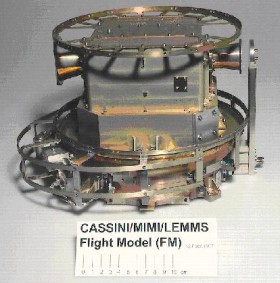 LEMMS is designed to measure the energy and spatial distribution of energetic particles (electrons and ions separately) in the interplanetary medium and in the magnetosphere of Saturn.
LEMMS is designed to measure the energy and spatial distribution of energetic particles (electrons and ions separately) in the interplanetary medium and in the magnetosphere of Saturn.
The LEMMS sensor is sponsored by the DLR (Deutsche Luft- und Raumfahrtagentur). DLR is the German counterpart of NASA.
LEMMS is based on a similar type of particle spectrometer which is currently flying on the NASA spacecraft ![]() GALILEO orbiting the planet Jupiter.
GALILEO orbiting the planet Jupiter.
LEMMS consists of the following subsystems:
![]() low energy detector head with collimator
low energy detector head with collimator
![]() high energy detector head with collimator
high energy detector head with collimator
![]() programmable turntable (manufactured in Finland by VTT)
programmable turntable (manufactured in Finland by VTT)
![]() electronics
electronics
The measurements of energetic particles are based on the loss of energy in semiconductor detectors. LEMMS has 11 different detectors E1, E2, F1, F2, A, B, D1, D2, D3a, D3b, D4
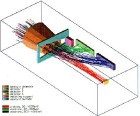 The low energy end of LEMMS is designed to measure low energy ions and electrons separately. An internal permanent magnet separates ions and electrons magnetically. The particles are detected with different detector systems inside the low energy end. The figure is the result of a simulation for the response of the low energy end of LEMMS (for details of the simulation contact Andreas Lagg (lagg@mps.mpg.de). Energetic particles enter the low energy end aperture from the left. Electrons are deflected by the magnet and counted by detectors E1, E2 (shown in green) and F1, F2 (blue) dependend on their energy. Ions are detcted by detectors A and B (shown in yellow).
The low energy end of LEMMS is designed to measure low energy ions and electrons separately. An internal permanent magnet separates ions and electrons magnetically. The particles are detected with different detector systems inside the low energy end. The figure is the result of a simulation for the response of the low energy end of LEMMS (for details of the simulation contact Andreas Lagg (lagg@mps.mpg.de). Energetic particles enter the low energy end aperture from the left. Electrons are deflected by the magnet and counted by detectors E1, E2 (shown in green) and F1, F2 (blue) dependend on their energy. Ions are detcted by detectors A and B (shown in yellow).
The whole assembly of the low energy end including the detectors E1, E2, F1, F2, A, and B and the permanent magnet are caged by a platinum box and a mu-metal shielding.
| Detector | Thickness [µm] | Active area [mm2] |
|---|---|---|
| E1 | 300±15 | 90 |
| E2 | 300±15 | 90 |
| F1 | 700±15 | 90 |
| F2 | 300±15 | 90 |
| A | 150±15 | 35 |
| B | 700±25 | 35 |
Between detectors B and the stack of D1..D4 of the high energy end a Gold-Absorber (1000 µm, 75 mm2) is inserted to stop particles not stopped in A or B.
| Detector | Thickness [µm] | Active area [mm2] |
|---|---|---|
| D1 | 150±15 | 100 |
| D2 | 700±25 | 150 |
| D3a | 700±25 | 150 |
| D3b | 700±25 | 150 |
| D4 | 700±25 | 150 |
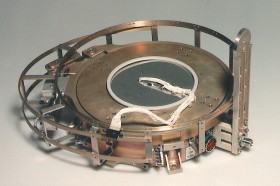 The programmable turntable was manufactured by
The programmable turntable was manufactured by
| order of accumulator readout |
channel name |
species | logic | low or high energy end |
|---|---|---|---|---|
| 1 | A0 | ions | A1(A2)(B1) | L |
| 2 | A1 | ions | A2(A3)(B1) | L |
| 3 | A2 | ions | A3(A4)(B1) | L |
| 4 | A3 | ions | A4(A5)(B1) | L |
| 5 | A4 | ions | A5(A6)(B1) | L |
| 6 | A5 | ions | A6(A7)(B1) | L |
| 7 | A6 | ions | A7(A8)(B1) | L |
| 8 | A7 | ions | A8(A9)(B1) | L |
| 9 | A8 | ions | A9(B1) | L |
| 10 | B0 | ions | A8(A9)B1(B5)(D41) | L |
| 11 | B1 | ions | A6(A8)B4(B5)(D41) | L |
| 12 | B2 | ions | A9B1(B5)(D41) | L |
| 13 | B3 | ions | A9B5(D41) | L |
| 14 | BE | ions | A2(A7)B1(B3)(D41) | L |
| 15 | C0 | electrons | E11(E12)(E21) | L |
| 16 | C1 | electrons | E12(E13)(E21) | L |
| 17 | C2 | electrons | E13(E14)(E21) | L |
| 18 | C3 | electrons | E14(E15)(E21) | L |
| 19 | C4 | electrons | E15(E16)(E21)+F11(F12)(F21) | L |
| 20 | C5 | electrons | F12(F13)(F21) | L |
| 21 | C6 | electrons | F13(E14)(F21) | L |
| 22 | C7 | electrons | F14(F15)(F21) | L |
| 23 | AS | singles | A1 | L |
| 24 | BS | singles | B1 | L |
| 25 | E11 | singles | E11 | L |
| 26 | E2F2 | singles | E21 | L |
| 27 | F11 | singles | F11 | L |
| 28 | E0 | electrons | D11(D12)(D21) | H |
| 29 | E1 | electrons | D11(D12)D21(D31) | H |
| 30 | E2 | electrons | (D11)D21(D22)(D31) | H |
| 31 | E3 | electrons | (D12)D21(D22)(D31) | H |
| 32 | E4 | electrons | (D12)D21(D22)D32(D33)(D41) | H |
| 33 | E5 | electrons | D21(D22)D32(D33) | H |
| 34 | E6 | electrons | D32(D33)D41(D42)(B1) | H |
| 35 | E7 | electrons | D41(D42)B1(B2) | H |
| 36 | G1 | (gammas) | (D21)D31(D32)(D41) | H |
| 37 | P1 | ions | D13(D15)(D21) | H |
| 38 | P2 | ions | D15(D16)(D21) | H |
| 39 | P3 | ions | D15(D16)D21(D23)(D31) | H |
| 40 | P4 | ions | D12(D16)D23(D24)(D31) | H |
| 41 | P5 | ions | D12(D15)D24(D25)(D31) | H |
| 42 | P6 | ions | D24(D25)D32(D34)(D41) | H |
| 43 | P7 | ions | D21(D25)D33(D35) | H |
| 44 | P8 | ions | D12(D15)D22(D23)D33 | H |
| 45 | P9 | ions | D22(D23)D32(D33) | H |
| 46 | H1 | ions | D16(D17)(D21) | H |
| 47 | H2 | ions | D16(D17)D21(D26) | H |
| 48 | H3 | ions | D25(D26)D32 | H |
| 49 | H4 | ions | D23(D25)D35 | H |
| 50 | H5 | ions | D22D34(D35)D45 | H |
| 51 | Z1 | ions | D17(D21) | H |
| 52 | Z2 | ions | D17D21(D31) | H |
| 53 | Z3 | ions | D26D32 | H |
| 54 | D1 | singles | D11 | H |
| 55 | D2 | singles | D21 | H |
| 56 | D3 | singles | D31 | H |
| 57 | D41 | singles | D41 | H |
| name | position | |
|---|---|---|
| Dr. N. Krupp | scientist | krupp @ mps.mpg.de |
| Dr. J. Woch | scientist | woch @ mps.mpg.de |
| Dr. A. Lagg | scientist | lagg @ mps.mpg.de |
| Dr. G. Jones | scientist | ghj @ mssl.ucl.ac.uk |
| Dr. E. Roussos | scientist | roussos @ mps.mpg.de |
| Dr. Z. Bebesi | scientist | bebesi @ mps.mpg.de |
| A. L. Müller | PhD student | muellera @ mps.mpg.de |
| P. Kollmann | PhD student | kollmann @ mps.mpg.de |
| H. Sommer | engineer | -- |
| A. Loose | engineer | loose @ mps.mpg.de |
| K. Heerlein | engineer | heerlein @ mps.mpg.de |
| date | location | calibration with |
|---|---|---|
| Dec 1995 | Goddard Space Flight Center (GSFC)
Greenbelt, Maryland, USA |
electrons |
| Mar 1996 | Kernforschungszentrum (KFA)
Jülich, Germany |
high energy protons and helium |
| 1996-1997 | Max Planck Institute for Solar System Research, Katlenburg-Lindau, Germany |
low energy protons, helium, oxygen |
| Feb 1997 | Goddard Spaceflight Center (GSFC)
Greenbelt, Maryland, USA |
electrons, H- |
| Mar 1997 | LBL, Berkeley,
California, USA |
high energy protons, helium, carbon, oxygen |
| © 2009, Max-Planck-Institut fŁr Sonnensystemforschung, Lindau |
Krupp 06-08-2010 |